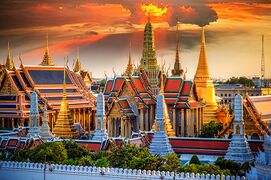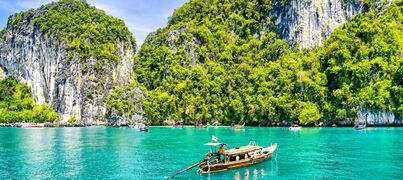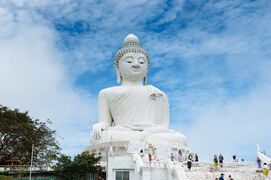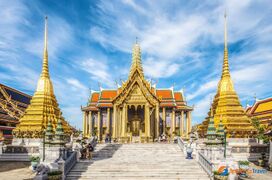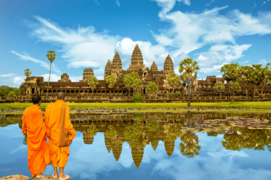Thervala
Thervala ("The Kingdom of Thervala") Ratcha-anachak Ther (Ther) | |
|---|---|
|
Flag | |
Motto: ชัยชนะด้วยเลือด ("Victory through blood") | |
Anthem: | |
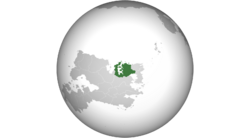 Location of Thervala (dark green) In Audonia (gray) | |
| Capital and largest city | Wat Kram |
| Official languages | Ther |
| Demonym(s) | Ther (noun) Ther (adjective) |
| Government | Constitutional Monarchy |
• King | Ananda Varma II |
• Prime Minister | Chatchai Suriyawan |
| Legislature | National Assembly |
| Senate | |
| House of Representatives | |
| Establishment | |
• Installment of the Varma Khram Dynasty | 03/25/1987 |
| Population | |
• Estimate | 80,000,000 |
| GDP (PPP) | estimate |
• Total | 7,800 |
| GDP (nominal) | estimate |
• Total | Your GDP = GDPPC x Population (This is calculated for you after first entry) |
• Per capita | Your GDP PC |
| Gini | Your gini coefficient Error: Invalid Gini value |
| Currency | Rathan (RTH) |
| Driving side | right |
Thervala, officially the Kingdom of Thervala, is a constitutional monarchy in Audonia. It is neighbored by Oyashima, XXX, and XXX
Although the modern state that is the Kingdom of Thervala has only existed for a few centuries, people have been living in that region of Audonia since prehistoric times. The borders of the Kingdom of Thervala have also remained consistent since the forming of the original Vishran Dynasties. For a majority of its history, the kingdoms that have existed in the region that is now known as Thervala have either been ruled by foreign dynasties or vassalized under stronger foreign powers.
The earliest recorded state in the region was a Peshabi dynasty of nobles from the Arunid Empire known as the Vishran Dynasty that came to the Thervalan region of Audonia in 200 BCE. The Vishran Dynasty introduced written language and civilization to the indigenous Ther population and much of ancient Ther culture is also linked to the Vishran Dynasty and this process is academically known as Arunidisation. The Vishran dynasty came to its eventual end due to the conquests of the Myanga Ayil Khanate. The capitulation of the Vishran Kingdom was largely bloodless, except for the Arunid ruling class. In the centuries that came after the formation of the initial kingdom, the Arunid ruling class became infamous for its hedonism and brutal style of ruling.
Because the indigenous ethnic Ther were collaborative with the Great Khan, an ethnic Ther dynasty was installed as a vassal under the Khanate in 1300 CE. This dynasty was known as the Khram dynasty, and is responsible for the founding of the Kingdom's capital city, Wat Khram. The Khram dynasty also issued edicts in regards to the development of the kingdom's civil and legislative codes, as well as making the state religion Theravada Buddhism. Modern Thervala can also trace its martial culture to the Khram dynasty, as part of the vassalization required the Khram Dynasty to provide the Khanate with a steady supply of well trained and well supplied troops to assist in the Khanate's conquest of Audonia.
The Khram dynasaty were loyal to the Khanate for centuries, largely due to the protection that was provided as well as the Khanate's laissez faire policy towards Ther self determination and national identity. As conquests started to take a toll on the Ther population, a sentiment for independence began to develop. It wasn't until 1650 that the Khram dynasty came into contact with Burgundie and the Ularien Trading Company (UTC). Upon establishment of Diplomatic missions, the Khram dynasty was more than willing to act as a collaborative force against the now hated Khanate.
As a protectorate of Burgundie, Thervala went through the process of Occidentalization, with Burgoignac trade companies supplying and funding the Khram dynasty with state of the art arms and armor, as well as modernizing the Kingdom's administration. The Khram dynasty worked closely both with Burgoignac trade companies and the neighboring Yuganagawa Protectorate in battles against the Myanga Ayil Khanate. This close relationship with Burgundie and their Oyashiman protectorate has influenced modern Ther culture immensely, with many loan words coming from Burgoignesc and Oyash.
Post colonial era, the Khram Dynasty maintained a close relationship with Burgundie and has helped maintain Burgoignac interests in Audonia, most notably in the war effort during Operation Kipling. During this time, Burgundie armed, trained, and funded the Kingdom's army. During this time an anti communist military junta was installed. This military dictatorship lasted until the late 1980s, when a military coup installed a monarchy from the Varma branch of the Khram Dynasty. Since then, the civilian government has changed multiple times through bloodless coups.
Currently, the Kingdom of Thervala is infamous for flagrant civil rights abuses, due to intense legislation against free speech, due to the far reaching Lèse-majesté laws that are legislated in the kingdom. The Kingdom of Thervala is also renown for spending a majority of its GDP on its military. The Kingdom of Thervala has also maintained close military ties to Burgundie, most notably Thervalan marines train alongside the Burgoignac military on a Biannual basis.
Thervala is a member of the League of Nations.
Etymology
The Ther people are the indigenous ethnic group of Thervala, and in the Ther language “Ther” directly translate to “Person” or “People”. “Vala” in Ther is an honorific title meant to denote a holiness or purity. Thervala is then representative not only of the borders of the country itself, but also its people. The Land of the (Holy People).
History
Prehistoric Age
In prehistory, Thervala was comprised of small, religious tribes that lived in fishing communities in and around the East Audonian wetlands. A majority of what is known from this time period comes from bog bodies found in and around swamps near major pre-historic settlements. It is heavily theorized that these bog bodies are instances of ritual sacrifice.
Arunidisation
Ancient Thervala's history is predominantly that of the Vishran dynasties. These dynasties were kingdoms ruled by families originating from the Arunid Empire. This period is significant for introducing a written system, marking the earliest recorded history of Thervala.
The Peshabi princes, originally from Peshab, were dispossessed of their lands by the Pukhti royal family. The Pukhti sought to consolidate power and distributed these lands to their growing network of royal sycophants. Forced to seek new opportunities, the Peshabi princes traveled north, following the end of the trade routes, until they encountered the tribes of the Ther people. Demonstrating remarkable leadership and strategic acumen, the Peshabi princes united the Ther tribes under the banner of the Vishran dynasty, establishing a new era of governance and cultural development in Thervala.
Vassalization under the Myanga Ayil Khanate
What were your country's first major moves on an international level?
Burgoignac Protectorate
Did your country ever have a period of significant decline or internal struggle?
Military Dictatorship
Was your country subject to imperialism later in its life, or was it an imperial power?
Modern Era
How did the 20th century affect your country?
Geography
-
Wat Khram at sunset
-
Phin Krat, a popular tourist destination - the largest island in the inner Ther peninsula
-
The National Buddha of Thervala, located on the outskirts of Wat Khram
-
The Imperial Palace of the Khram Dynasty
-
Wat Vishran, the ancient capital of the Vishran Kingdom
Climate and environment
Thervala is a subtropical nation with a large amount of marshland on its mainland Audonian territory. A mountain range to its south makes up a natural border between The Kingdom of Thervala and its bordering nations. The central part of the nation is largely tropical and is comprised of the main Peninsula of Thervala which has over a thousand islands. In the southwest of the country is the Thrak'Tee river. The Thrak'Tee river flows from central Audonia all the way to Wat Khram.
Government and Politics
The Kingdom of Thervala is governed by a de facto democratically elected civilian government but a de jure military government via majority seats in government.
Executive
The King of Thervala is largely a figurehead, but still retains a handful of executive functions and remains influential over the legislature. The main wielder of executive power in the country is the prime minister, who is an elected representative from the legislature. A majority of legislation drafted and passed by the legislature is written "in the interest" of the king.
Legislative
The legislative branch of the country is made up of an upper and lower house, which are comprised of elected officials from the various political parties of the country. Each political party elects a representative who will then run for the position of prime minister.
Federal subdivisions
The Kingdom of Thervala is comprised of ten provinces. These provinces' borders were created when the Khram dynasty was initially installed and are representative of the ten precepts of Buddhism. Each province is granted seventy seats in the Parliament.
Politics
Thervala has a handful of major political parties that ebb and flow in power. However, since the 1985 democratic coup, the ruling party has been the Royal party. The other major parties that have consistently held seats in the Thervalan parliament are the Fascist Party of Thervala (FPT), Thervala Social Democrat Party (TSDP), and the Green Party.
Law
Thervala is infamous the world over for its extremely harsh legal system. It employs torture of all kinds and has a sentencing rate of 97.5%. Prisons in the Kingdom of Thervala are also incredibly strict, regimented, and allegedly rife with human rights abuses. In Thervala, there is no separation between the military and law enforcement, they are one in the same. Thervala has an incredibly low crime rate due to its incredibly strict punitive measures.
Demographics
Ethnicity
Self-reported ethnic origin in the Kingdom of Thervala (2030)
What ethnic groups make up your country?
Language
Ther is the predominately spoken language in Thervala. Due to the kingdom's historic ties with Burgundie, Burgoignesc is a common second language as it is required by law to be taught in school. Oyash and Daxian are also spoken in Thervala, usually within immigrant communities.
Religion
Religious affiliations in the Kingdom of Thervala (2030)
The Kingdom of Thervala is a predominately Theravada Buddhist nation due to it being the state religion. However, there is a large Confucian base in the country from Daxian immigration. Also, due to Burgoignac influence, there is a sizable population of Mercantile Reform Protestants in the country.
Culture and Society
Education
What is your country's education system like? How do the schools work? What do people think about education?
Attitudes and worldview
How do your country's people view life?
Kinship and family
How are families or kinship groups structured in your country?
Cuisine
What do your people eat?
Religion
What do your people believe? Rather than demographics, as above, think about how important religion is to your people and their view about their own and other religions. What is the relationship between the prevailing view and minority religious groups? Is it an official religion, and do any laws exist about free worship?
Arts and Literature
What type of art do your people make? Do they have a tradition of painted art, well-crafted television shows, or great music?
Sports
Does your country have any major sports leagues? What types of sports are played, both professionally and for fun by your country's people?"
Symbols
Are there any prominent symbols which are well known to represent your country?
Economy and Infrastructure
How does your country's economy work?
Industries and Sectors
What are the largest parts of your economy in terms of what they do?
Currency
What exchange systems are used within your country's economy?
Healthcare
How do people in your country procure medical care? How is it paid for?
Labor
How is labor organized within your country? Are there any social institutions or unions which deal with labor concerns?
Transportation
How do people in your country get around? Is there a major highway system as well as sea- and airports?
Energy
What type of energy keeps your nation going? Are you renewable or use fossil fuels, and if you are renewable, how recently did your country transition?
Technology
How advanced is your country? Is it an innovator, or does it largely import new developments?
Military
How large is your country's military? Is it large but poorly equipped or small and elite? Does your country have a martial tradition?

